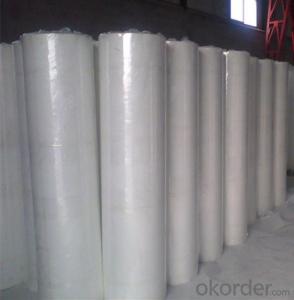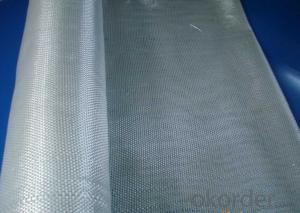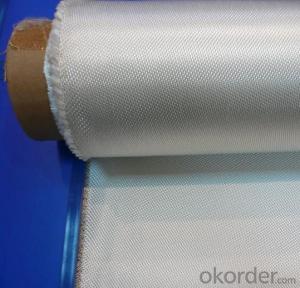Fiberglass Yarn - High Strength Non-Alkali Fiberglass Yarn
- Loading Port:
- Ningbo
- Payment Terms:
- TT OR LC
- Min Order Qty:
- 500 kg
- Supply Capability:
- 300000 kg/month
OKorder Service Pledge
OKorder Financial Service
You Might Also Like
Description: Fiberglass yarn is a fiberglass twisting yarn.Its high strength, corrosion resistance, high temperature resistant, moisture absorption, good electrical insulating performance, used in weaving, casing, mine fuse wire and cable coating layer, the windings of electric machines and appliances insulating material, various machine weaving yarn and other industrial yarn.
Features: high temperature, chemical, and abrasion resistance, fire retardant

PRICE: USD7 per kilogram
UNIT: Kilogram
MOQ: 100 KGS
Weight: 0.7kg, 2kg, 4kg
Yarn Type: E-glass
Product name: Fiberglass Yarn
Diameter: 3-9um
Linear Density: 33tex
Alkali content: Alkali free
Material: fiberglass
Surface Treatment: Vinyl Coated
Yarn Structure: Single Yarn
Supply ability: 5000 Ton/Tons per Day
Packaging: opp bag, then carton box
Lead time: 7-30 days
- Q: What are the different weaving patterns available for fiberglass yarn?
- Fiberglass yarn can be woven into various patterns, each with its own distinct characteristics and uses. Some commonly used weaving patterns for fiberglass yarn include plain weave, twill weave, satin weave, leno weave, and basket weave. Plain weave, the simplest and most prevalent pattern, involves each yarn going over one and under the next in both the warp and weft directions. This creates a balanced and strong fabric with good stability and a uniform appearance. Twill weave, on the other hand, interlaces the yarns in a diagonal pattern, resulting in a noticeable diagonal line on the fabric surface. Twill weaves offer excellent drapability, durability, and strength, making them suitable for applications requiring flexibility and abrasion resistance. Satin weave produces a smooth and lustrous surface due to its floating yarns. Each yarn passes over three or more yarns before going under one, creating long floats. Satin weaves are known for their superior drape, softness, and sheen, making them ideal for applications that require a luxurious appearance, such as upholstery or high-end clothing. Leno weave is characterized by pairs of warp yarns twisting around weft yarns to form a stable mesh-like structure. This type of weave creates a breathable and open fabric with good transparency. Leno weave is commonly used in applications that require air circulation or filtration, such as mosquito nets or industrial filters. Basket weave is similar to plain weave, but with two or more yarns woven together as one in both the warp and weft directions. This pattern creates a fabric with a checkerboard-like appearance and enhanced stability. Basket weave is commonly used in applications that require a sturdy and rigid fabric, such as packaging materials or upholstery. These various weaving patterns offer fiberglass yarn a wide range of possibilities, allowing it to be customized to meet specific needs in terms of strength, flexibility, breathability, transparency, and appearance.
- Q: Is fiberglass yarn suitable for use in medical applications?
- Fiberglass yarn is generally not suitable for use in medical applications. While fiberglass has many beneficial properties, such as being lightweight, strong, and resistant to chemicals, it also poses certain risks and limitations when it comes to medical use. One of the primary concerns with fiberglass yarn is its potential to cause irritation or allergic reactions when it comes into contact with the skin. This can be particularly problematic in medical applications where the yarn may be in direct contact with patients, especially those with sensitive or compromised skin. Moreover, fiberglass fibers can break off and become airborne, posing a risk of inhalation or ingestion, which can lead to respiratory or digestive issues. Additionally, fiberglass yarn is not inherently antimicrobial, meaning it does not possess inherent properties to resist the growth of bacteria or other microorganisms. In medical settings, where hygiene and infection control are of utmost importance, using materials that have antimicrobial properties is desirable. Therefore, medical applications typically require materials that are specifically designed and tested for their suitability in healthcare settings. These materials often focus on being hypoallergenic, non-toxic, and antimicrobial to minimize the risk of adverse reactions and infections. In summary, while fiberglass yarn has several positive attributes, it is generally not considered suitable for use in medical applications due to its potential to cause irritation, its lack of antimicrobial properties, and the risk of airborne fibers.
- Q: Can fiberglass yarn be used in insulation materials?
- Insulation materials can indeed utilize fiberglass yarn. Such yarn is created by spinning molten glass into fibers, which are then woven together to form a yarn. This yarn can serve as a reinforcement material in insulation products, thereby enhancing their strength and resistance to tearing or breaking. Furthermore, fiberglass yarn possesses outstanding thermal insulation properties, making it a perfect option for insulation materials. It effectively traps air and prevents heat transfer, thereby ensuring buildings remain cool during summer and warm throughout winter. Ultimately, due to its strength and thermal insulation capabilities, fiberglass yarn is widely employed as a crucial component in insulation materials.
- Q: What are the different deniers available for fiberglass yarn?
- There are several different deniers available for fiberglass yarn, which refer to the thickness or fineness of the individual fibers within the yarn. Some common deniers for fiberglass yarn include 300D, 600D, and 1200D. The denier of fiberglass yarn is determined by the weight in grams of 9000 meters of the yarn. A lower denier such as 300D indicates a finer and lighter yarn, while a higher denier like 1200D suggests a thicker and heavier yarn. The choice of denier for fiberglass yarn depends on the specific application and desired properties. A finer denier may be suitable for applications that require flexibility, softness, and a smoother appearance. On the other hand, a higher denier yarn may be preferred for applications that require strength, durability, and resistance to abrasion. It's important to note that the denier of fiberglass yarn can also affect its other characteristics, such as tensile strength, heat resistance, and electrical conductivity. Therefore, when selecting a denier for fiberglass yarn, it is crucial to consider the specific requirements of the intended use to ensure optimal performance.
- Q: Is fiberglass yarn suitable for outdoor applications?
- Yes, fiberglass yarn is suitable for outdoor applications. Fiberglass is known for its strength and durability, making it a popular choice for various outdoor uses. It is resistant to weathering, moisture, and UV radiation, making it ideal for outdoor applications where exposure to harsh conditions is a concern. Additionally, fiberglass yarn is lightweight and flexible, allowing it to be easily woven or knitted into different fabrics or materials that can withstand outdoor elements. Whether it's used in outdoor furniture, awnings, tents, or even in construction materials, fiberglass yarn provides a reliable and long-lasting solution for outdoor applications.
- Q: Can fiberglass yarn be used for reinforcement in wind turbines?
- Indeed, wind turbines can employ fiberglass yarn as a reinforcement. Renowned for its exceptional tensile strength, durability, and resistance to corrosion, fiberglass yarn proves to be an optimal substance for fortifying different structures, including the blades of wind turbines. By serving as reinforcement, fiberglass yarn bolsters the overall strength and rigidity of the blades, enabling them to endure the formidable winds and pressures they encounter while in operation. Furthermore, the lightweight nature of fiberglass yarn contributes to the optimization of wind turbine performance and efficiency. In summary, the utilization of fiberglass yarn as reinforcement in wind turbines is a widespread and efficacious practice within the industry.
- Q: Is fiberglass yarn resistant to moisture or humidity?
- Yes, fiberglass yarn is resistant to moisture and humidity. Fiberglass is a synthetic material made from fine fibers of glass, which are then spun into yarn. One of the key properties of fiberglass is its resistance to moisture and humidity. Unlike natural fibers such as cotton or wool, fiberglass does not absorb moisture. This means that it will not become damp or retain water when exposed to humid conditions. Additionally, fiberglass is also resistant to mold and mildew growth, which are commonly associated with moisture and humidity. Therefore, fiberglass yarn is an excellent choice for applications where resistance to moisture and humidity is required, such as in the manufacturing of outdoor fabrics, insulation materials, and composite materials.
- Q: Is fiberglass yarn suitable for automotive applications?
- Yes, fiberglass yarn is suitable for automotive applications. It is commonly used in the automotive industry for its high strength, heat resistance, and durability. It is used in various automotive components like insulation, reinforcements, and composites, providing improved performance and safety.
- Q: Can fiberglass yarn be used for making industrial gloves?
- Industrial gloves can indeed be made using fiberglass yarn. Fiberglass is a remarkably robust and long-lasting material that can endure extreme temperatures, chemicals, and abrasion. This renders it highly appropriate for industrial settings where gloves must offer defense against heat, chemicals, and other potential dangers. Fiberglass yarn can be utilized in weaving or knitting gloves, granting them a superior level of resistance and protection. Furthermore, manufacturers frequently apply coatings of materials like latex or nitrile to fiberglass gloves, thereby enhancing grip and further reinforcing their protective properties. All in all, fiberglass yarn stands as a suitable option for producing industrial gloves due to its strength, durability, and resistance to various hazards.
- Q: Can fiberglass yarn be used in reinforcement of concrete pipes?
- Indeed, concrete pipes can be reinforced with fiberglass yarn. Renowned for its exceptional corrosion resistance and high tensile strength, fiberglass yarn proves to be an optimal material choice for reinforcing concrete structures. By incorporating fiberglass yarn into the concrete mixture, the overall robustness and endurance of the concrete pipes are significantly heightened, granting them enhanced resistance against cracking, impact, and external forces. Furthermore, fiberglass yarn aids in averting crack formation caused by temperature fluctuations and shrinkage, thereby securing the long-lasting durability and structural soundness of the concrete pipes.
Send your message to us
Fiberglass Yarn - High Strength Non-Alkali Fiberglass Yarn
- Loading Port:
- Ningbo
- Payment Terms:
- TT OR LC
- Min Order Qty:
- 500 kg
- Supply Capability:
- 300000 kg/month
OKorder Service Pledge
OKorder Financial Service
Similar products
Hot products
Hot Searches
Related keywords
























